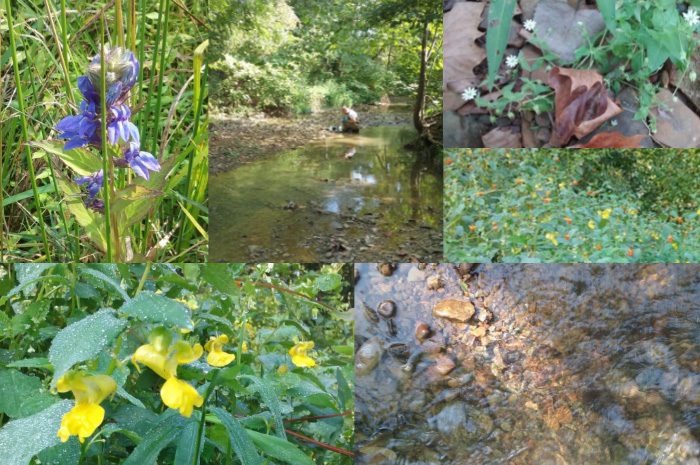My work at MBI is, in many ways, a dream come true. Working alongside aquatic ecologists who are experts in their field is a privilege. Helping support our crews, who do the heavy lifting when it comes to bio-assessment and data collection, is truly an honor. And I enjoy working with our instructors to prepare course materials and assist with education courses. These folks truly care about the well-being of our natural environment and they work hard making a difference for our students, our clients and the health of the watersheds we assess.
For me, after many years of working in fast-paced customer service for larger companies, the seasonal ebb and flow of activity at MBI is refreshing. At our very small organization, my role of admin assistant offers plenty of variation in job duties. In our peak season I am often busy sorting through piles of receipts, processing credit card statements, and printing education course materials. While the aquatic ecologists analyze their samples and put reports together during the winter, my activities include assisting with outreach, archiving old files, document destruction, organization, performing cost analyses, and scanning & indexing old data sheets. As the daughter of two nature lovers who grew up out in the country by the woods, I feel at home being outdoors. Sometimes I get a little jealous of the crews who get to be outside all the time in the warm season – that is, until it rains or becomes uncomfortably hot. Then I’m happy to have a desk job!
One day, management asked if I was interested in getting out from behind the front desk and helping our fish crew in the field. Yes!! I jumped at the chance. In this case my ability to drive a long-bed pickup truck meant I could help transport freshly taken water samples back to the lab. This would save fish crew at least 6 hours of drive time and an overnight stay.
When our field day came, just after Labor Day, the weather was sunny and temperate – perfect for exploring. We met at the office at 7am and got underway. I drove one truck with Fish Ecologist and Field Crew Leader Matt Sarver as my co-pilot, and two big coolers in the back. The other two guys, Zach and Justin, took a second truck with all the fish crew equipment.
It was too early for conversation on the way down – we quietly sipped our coffee as we headed south, stopping to fuel up and get breakfast about halfway there. Fish crew was heading to sample a tributary to the Scioto River just 20 minutes’ drive north of the Ohio River.
The first site was on a farmer’s property. The farmer had previously given our crew permission to sample there, and when we arrived we turned off the road and into a field of grass. Across this wide field we drove, and stopped near the stream. While Matt and the crew put their waders on and got their equipment ready, I took the opportunity to stretch my legs and do a little exploring. In the gentle morning light, the dew glistened on every blade of grass. A sea of jewelweed at the edge of the field immediately drew my attention, its leaves adorned with dewdrops that sparkled silver in the sunrise.
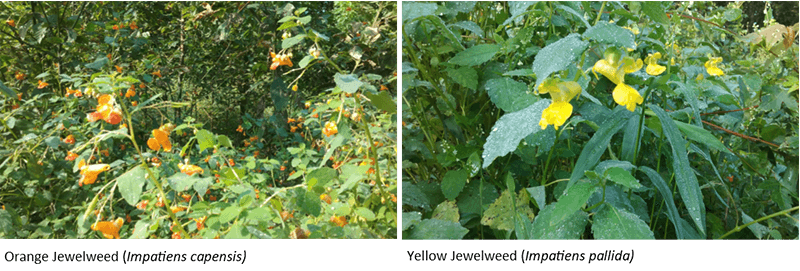
One way to identify jewelweed is that its leaves suddenly appear silver when submerged in water. This is because microscopic hairs on the surface of the leaf capture a layer of air. Also known as touch-me-not, this flower can be surprising when its seedpods mature. In late summer and early fall, a touch can trigger the coiled spring inside the capsule to catapult the seeds in all directions! My father had introduced my sister and me to this plant when we were little girls. One day on a walk in the woods, after refusing to heed our parents’ warnings, we ran headlong through a patch of stinging nettles. Dad promptly crushed the stems of some jewelweed plants growing nearby and used the mucilage inside to soothe our burning skin. How convenient this plant can often be found growing beside irritating species like nettles and poison ivy!
Down by the water’s edge I documented the various wildflowers growing there. Now as I write this, five months later, I wish I had made more systematic observations. Trying to key out a wildflower can be difficult without knowing certain things… like whether its leaves are alternate or opposite, whether it has basal leaves or not, etc. Fortunately with the help of the Wildflower Identification Website at https://wildflowersearch.org/, identification done afterward is a lot easier. This amazing resource allows you to enter the location where you found your specimen, the time you observed it, and other attributes like the flower color, leaf attachment and habitat. Then it pulls up pictures of possible matches. This made it easy to ID the blue mistflower and others, even without the observational info I wish I had recorded in the field.
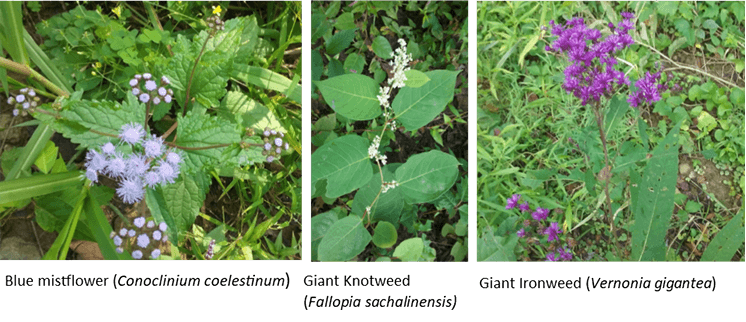
During MBI’s first citizen science class last year, I had learned about the importance of the substrate and took some pictures of it, along with pictures upstream and downstream of the sampling site.
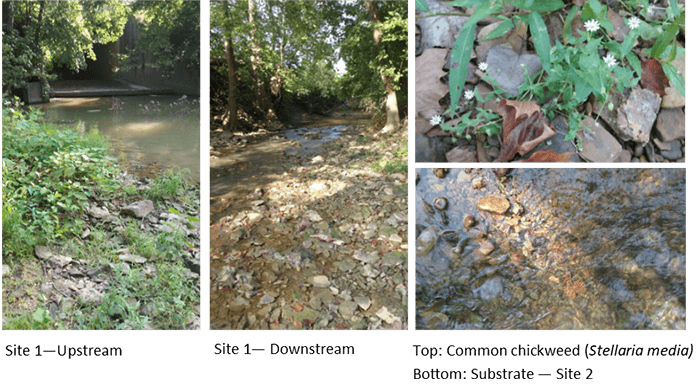
At each site, Matt would carefully wade upstream and fill vials with water samples as I walked around taking pictures. We went to three sites fairly quickly, and then it was time to do the fourth site.
Getting to the fourth site required our crew to first cross the stream and open the steel gate on the other side. Then with Matt’s encouragement, I drove the truck across the stream, up the opposite bank and into a meadow with tall grasses and wildflowers. We had entered a protected conservation area, and it was beautiful. After following the tire track a short distance into the meadow, we parked the truck and Matt went to get his samples. Here are some pictures of the wildflowers growing in the meadow.
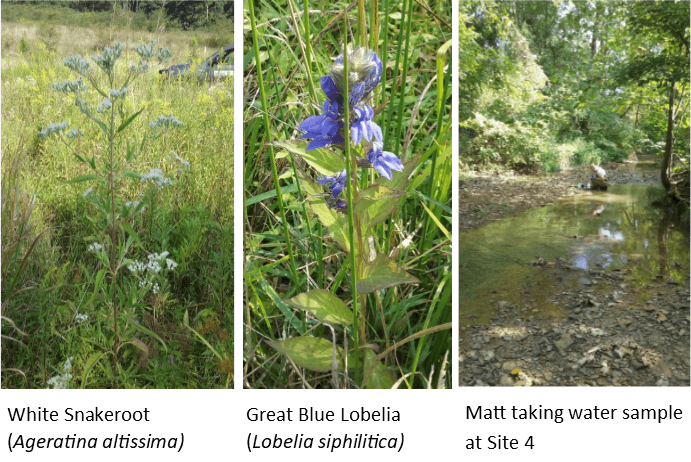
With the sun getting higher overhead and being unprotected by the forest canopy, it was getting pretty hot. I followed Matt into the stream channel where there was more shade, snapping a picture of him when the water got too high. Turning around I headed back towards the truck, and that was when a tiny white flower caught my eye.
Growing right at the water’s edge was this little white flower growing on a vine. I snapped a picture of it and looked around for more, but didn’t see any. In retrospect, I wish I had taken pictures from multiple angles and jotted down some notes that would have helped in identification. Initially identified as a small white morning glory (Ipomoea lacunosa) using Newcomb’s Wildflower Guide, I was not convinced because the flower shape and structure looked different to me. After being unable to find a closer match on the Wildflower Search website, I joined two Ohio botany groups on Facebook. Several weeks later, someone said the flower structure and petal shape of this species is variable. Mystery solved!
One of my favorite finds that day was the Wild Bean, also a streamside vine.
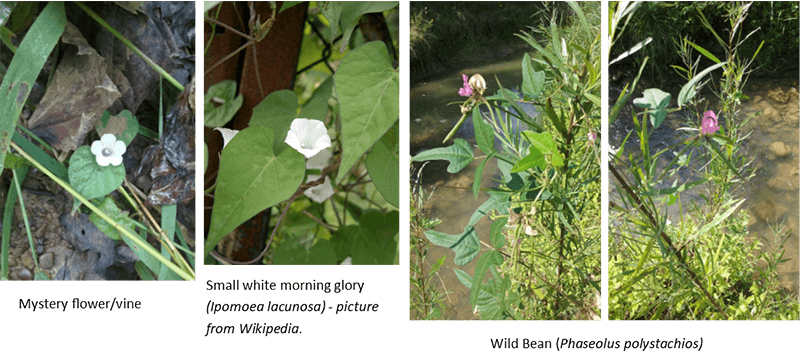
Shortly after taking these pictures, Matt returned and we went over the samples in the coolers and what I was supposed to do with them. I carefully turned us around and navigated the tire track back the way we came. After driving back across the stream, this time I left Matt with the crew and disembarked.
The rest of that day involved me doing a lot of driving by myself and feeling grateful for cruise control. I won’t bore you with the details. I ate my packed lunch as I drove, got to the lab in Marion about 3 hours later, and made it to the lab in Westerville just as rush hour was starting to get serious.
Next time I have a chance to get out in the field, I will be sure to bring a Newcomb’s Wildflower Guide and a notebook, and be more systematic about writing down observations of the botanical specimens I find! When ID is not possible in the field, having pictures of each plant from multiple angles, and of certain key features of the plant will help with identifications done later. I always enjoy meeting new plants and love to be able to recognize them again later. As my husband and I learned when we lived and worked on a micro-farm, learning to identify plants can be overwhelming! There is so much to learn. Eventually you begin to see patterns, and my seed box at home is now organized by plant families instead of alphabetical order. I am looking forward to getting out in the field again and meeting some new plants this year!

